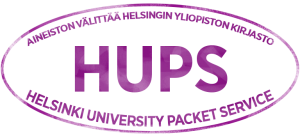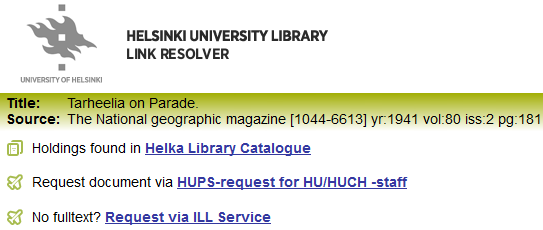Terms of use must be accepted before you continue using MOT.
Choose “I accept the terms of use” from the upper right corner.![]()
Terms of use must be accepted with every browser / when you clear browser history.

Helsingin yliopiston kirjasto – Helsingfors universitets bibliotek – Helsinki University Library
Talentum dictionaries are not available after 6.5.2016
MOT Pro Englanti and MOT Pro Ruotsi will replace Talentum dictionaries, starting from 1.6.2016.
Link to MOT dictionaries.
Physical copies of Suomi-Englanti Suursanakirja are also available in the Main library.
Research Data Management – Guide tells you the data storage services and policy at the University of Helsinki. You can also learn more about UH recommendations for sharing & reuse of research data.
 The management of research data refers to creating and storing research data and related descriptive metadata so as to preserve the usability and reliability of the material.
The management of research data refers to creating and storing research data and related descriptive metadata so as to preserve the usability and reliability of the material.
See also:
Tuuli (DMP tool)
ResearchGuides – Library’s information sources from various research fields, expert librarians and help guides
The ResearchGuides lists a selection of major information resources in various research fields provided by the Library. It is made especially for researchers and advanced students.
We have designed two more guides on Art studies :
Library guides are especially designed to fulfill researchers’ information needs. You will find the most relevant sources of information, core databases, journals, articles and news feeds from our guides.
More practical library guides relevant to Art Studies:
What is it all about?
ResearchGuides – Library’s information sources from various research fields, expert librarians and help guides
The ResearchGuides lists a selection of major information resources in various research fields provided by the Library. ResearchGuides collects library’s information sources and services from the viewpoint of each research field. It is targeted especially for researchers and advanced students.
The reservations of the student group areas in Aleksandria move from the varaus.it.helsinki.fi system to Office 365 as of 1 January 2016. The old varaus.it.helsinki.fi will be shut down in January 2016.
In Office 365, the reservations are made using the dedicated calendar where students have the right to make reservations.
Reservations already made for year 2016 are not transferred automatically to Office 365. If necessary, the IT Center contacts the people who have already made such reservations.
After Epiphany the Main Library in the Kaisa House extends its opening hours on weekdays. The Kaisa House opens at 8:00 am from Monday to Friday.
The library’s customer service is available from 9:00 am, but other facilities can be used from an hour earlier.
Please note that in the mornings between 8 and 9 am the library is being cleaned, so complete silence cannot be guaranteed.
Starting January 2016 the Main Library in the Kaisa House and The Viikki Campus Library will launch self-service for picking up reserved books.
Reserved books can be picked up from the customer service areas in the libraries after the customer has received a notice of arrival. Reserved items are in the open shelves alphabetized by the customer’s name. The customer can check out the reserved books on the self-service check-out stations like any other books.
Textbooks are subject to a reservation fee (1 euro / book). Please note that the fee will be added to customer’s data as soon as the book is ready for pick up. Other than textbooks can still be reserved free of charge. The fee for all requests that have not been picked up is €2/book if the request has not been cancelled before the notice of arrival.

If you do not wish your name visible on open shelves, please contact the library. You can agree to pick up your reservations at the service desk as before.

HUPS is a Helsinki University Library’s service for researchers, using which the Helsinki University and HUCH staff can order books and copies of journal articles free of charge from the Helsinki University Library’s collections.
The material is delivered directly to researcher and the researcher therefore does not have to retrieve it from the library personally.
Some researchers have already become regular users of the service.
Literature arrives in the mailbox
Trial of the HUPS service started in May 2015. In half a year, over 300 orders have been made from all over the University. Requests have mostly been for article copies, little more than a third of the orders have been books. As a rule, orders have been delivered within a few days.
Place an order here!
Order can be made by using this form.
You will find the form by following the HUPS logo on the library’s website, on Flamma-intranet, in Terkko Navigator and in ResearchGuides.
In the near future HUPS-logo will appear also in your search results, when searching library resources on the Library’s website.

Next year the funding of the Helsinki University Library is cut more than 2 million euros compared to the year 2015. The large savings have an impact to material purchases e.g. the Library is unable to continue all journal subscriptions and the access to some of the current databases cannot be guaranteed.
To keep the material cut as small as possible the Library is going to renew its services and reduce some of the facilities in a controlled way.
All the disciplines have been treated equally, the reduction affects all, says the Service Director Annikki Roos. The weeding of resources has been difficult, diminishing the standard of service is not pleasant to anyone.
The resources on the reduction list have been thoroughly evaluated. In addition to the user figures the Library’s information specialists have calculated e.g. the price of one use per a certain journal and also done retrospective analysis of the development of costs. Other evaluation methods have been e.g. journal’s JUFO-classification, impact factors, reference analyses and the feedback from researchers.
However, we must remember that the majority of subscriptions continue as before and new material is also acquired, says Annikki Roos.
The weeding includes all resources from e-journals to text books. The Library has already been prepared for the future by acquiring new e-book packages and reference material for the year 2016.
As a rule the Library acquires resources as e-books and e-journals. The acquisition of printed text books is bound to diminish due to the cutting of funds.
When planning the course requirements the teachers could benefit more than before from e-books, digital journal articles and open access publications.
The Library wishes that when the faculties and departments evaluate the renewals of course requirements they would also take into consideration the cost of material.
In future the students have to be prepared to co-operate with other course attendants in a way that enables the course material for all, or to purchase the literature with own funds.
The increase in scientific open access publishing brings a little glimpse of hope to the gloom due to the fund cuts in the University and its Library, states the University Librarian, Professor Kimmo Tuominen from the Helsinki University Library.
For example parallel saving of article manuscripts to the University’s open-access digital archive Helda is recommendable to all researchers. We have to advance and take action step by step in order to change the unfavorable cost structure and to enhance the open and unrestricted publication of scholarly articles.
Open science is one of the University’s key goals in the next strategy term. The University has signed among other things LERU’s Christmas is over statement and the Haag declaration, both of which react to the present situation in scientific publishing and to the control of copyrights which affect unfavorably the development in research activity.
Autumn is the time of University Rankings. In August we got Shanghai, in September QS World University and now Times Higher Education (THE). The latter offered the University of Helsinki a considerable rise from place 103 to 76.
Let´s see more detailed which role the bibliometric methods play in these results. In the Shanghai ranking they comprise 40% of the total result, in the QS ranking only 20%. In the THE ranking references bring 30% of the result and publication volume 6%.
Sometimes databases can play a central role. Instead of Web of Science, THE is now for the first time using Scopus. This crossover has also raised the rankings of other European and Finnish universities in contrast to American Universities whose ratings now sank. However, also QS uses Scopus but in its ratings the ranking of the University of Helsinki has sunk. Explanation to this is the significant change which has taken place in the means of measuring. Five of the largest disciplines are now equally emphasized. In this method medicine and natural sciences usually lose impact in publication ratings.
Library and Metrics Tools
Shanghai ranking uses the Web of Science in its quantitative method likewise Taiwan (TNU) ranking, which results we expect in October. TNU rankings are solely based on the bibliometric indicators.
Both Web of Science and Scopus are accessible in the University of Helsinki network, likewise the Analyzing tools of these databases: InCites and SciVal. The Helsinki University Library´s Metrics team actively uses these tools as part of their analysis.
Text: Eva Isaksson
Translation and editing: Ursula Virolainen